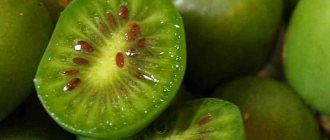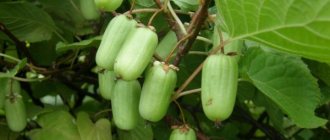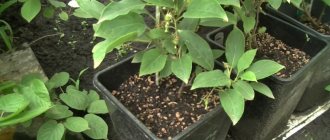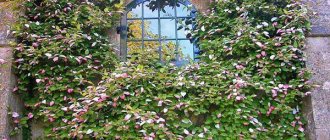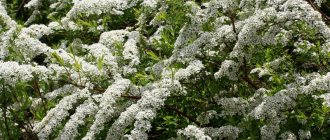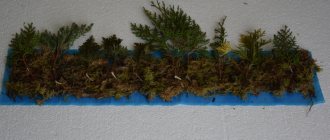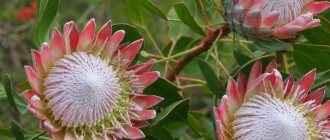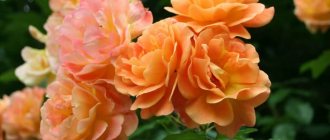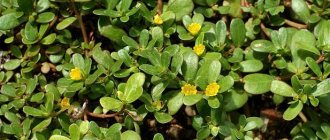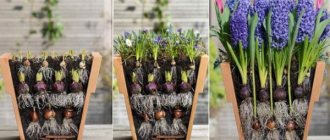Few people know that you can grow kiwi in your own garden, in open ground. The plant's homeland is Asia, where it can be found in the wild. These fruits were brought to Europe from New Zealand. In autumn, you can enjoy their taste and maintain your health with the beneficial properties of the fruit. The amount of vitamin C contained in the fruit is 10 times more than in black currants.
Recently, this vine has gained great popularity among gardeners. And this is not surprising! Actinidia is unpretentious, planting and caring for the plant will not take much time.
Plant characteristics
Actinidia is an ornamental foliage plant native to China, also called mini-kiwi. Based on it, many winter-hardy varieties have been bred, which are successfully grown in Russian conditions. The plant bears fruit with delicious berries; growing, pruning and caring for actinidia does not cause much trouble.
Botanical description of actinidia:
- This is a shrubby vine from the Actinidia family (Actinidiaceae).
- Actinidia is characterized by a compact arrangement of serrated, ovate or heart-shaped leaves.
- The flowers of the plant are usually white or cream and small.
- The fruits are small, reminiscent of gooseberries.
Photo – actinidia fruit
- Bushes can be monoecious or dioecious. Monoecious plants do not require pollination - male and female flowers are found on the same bush. Dioecious vines need to be planted with at least 2 specimens per site - a male plant and a female plant, which produces fruit after pollination.
Actinidia fruits resemble kiwi in appearance and taste. They are used fresh and for processing. However, this is not the only reason why the shrub gained popularity. The plant is often used for landscaping. Beautiful actinidia flowers bloom in early summer, and the fruits ripen by autumn.
Use of actinidia
Actinidia can be used for landscaping winter gardens, insulated large balconies, loggias, and verandas. Its fruits are very beneficial for the intestines and other organs. They can be used raw, as well as pickled, dried, made various preserves and jams, cooked compotes and jelly.
It can also cleanse your body and give it lightness. Also, the fruits of this plant are actively used in folk medicine because they are known for their healing properties. People have long adapted to brew various decoctions and tinctures that help cope with colds, get rid of worms, problems with the gastrointestinal tract and simply strengthen the immune system.
With careful care, you will have a wonderful plant growing in a short period of time.
For example, look at the actinidia vine in the photo below:
If you take care of the plant right away, after a while it will give you an incredible aroma, tasty and juicy fruits, and will also become an original decoration for any area!
- Author: admin
Rate this article:
- 5
- 4
- 3
- 2
- 1
(6 votes, average: 3.2 out of 5)
Share with your friends!
Beneficial properties of fruits
The more actinidia is watered, the better and faster it grows. It produces a lot of juicy fruit. These fruits are a source of natural vitamins.
Minikiwi contains many useful substances:
- 100 grams of minikiwi contain up to 1500 milligrams of vitamin C;
- minerals – potassium, calcium, manganese, lutein;
- potassium (high content, similar to that of bananas);
- calcium (more than in apples);
- a large amount of iron, magnesium.
Chemical composition, nutritional benefits and medicinal properties
Compound
Ripe berries contain about 17% dry matter, organic acids (1.1-1.4%) and sugars (5.6-8.6%). In terms of vitamin C content (about 800 mg), only rosehip competes with actinidia. Blackcurrant is inferior to it in this indicator by 3-4 times, and citrus fruits by 10-13 times.
The vitamin C content increases as the fruits ripen, reaching its maximum value in the phase of full ripeness.
The amount of P-active substances is 30-50 mg%. The content also contains carotene (0.2-0.35 mg%). The composition includes tannins, dyes, macro- and microelements.
Nutritional benefits
Actinidia berries are a valuable raw material for processing. Jam, compotes, marmalade, candied fruits, marshmallows, juices and wines are an incomplete list of products obtained from the fruits of this vine.
To prepare raw jam, the berries are ground with sugar until it is completely dissolved (40% berries and 60% sugar).
Such jam, 10-15 g of which contains the daily intake of ascorbic acid, can be stored well in the refrigerator for a year without significant loss of vitamin C. jam and jam resemble apple jam.
When the jam is cooked correctly, the berries do not become soft. Due to the fact that the acidity of the fruit is low, food acid is added during processing. To prepare the fillings, it is better to use a mixture of 30% crushed actinidia fruits, 10% pureed (seedless) lemongrass fruits and 60% sugar.
Fruits can be dried in a stove or oven at 50-60 °C.
juice , when naturally fermented with the addition of sugar, turns into a natural golden yellow wine with a bouquet reminiscent of aged Muscat wines. Featuring a high content of ascorbic acid (up to 600 mg per 1 liter after 3 years of storage), the wine is healing.
Medicinal properties
Actinidia berries are a valuable antiscorbutic remedy. Eating 3-5 dried berries a day protects against disease. They are useful after severe infections, during physical and mental stress, and constipation.
Actinidia tincture relieves angina attacks. The bark of this vine contains glycosides with cardiac effects.
Contraindications
It is not recommended to consume actinidia in large quantities for diabetes and obesity.
Types and varieties
Today there are several species and many varieties of actinidia have been developed.
In our conditions, 4 species are often grown:
- Actinidia arguta;
- Chinese (Actinidia chinensis);
- Purple (Actinidia purpurea);
- Actinidia kolomikta.
Arguta
Actinidia reaches a maximum height of 4-10 meters. The plant remains attractive for a long time because it sheds its leaves only at the end of autumn. White flowers with a greenish tint appear in June. Small fruits turn brown on the side exposed to the sun. The plant begins to bear fruit approximately 2-4 years after planting. The annual growth of the vine is approximately 1-2 meters.
Popular varieties of actinidia Arguta - description and photo
| Variety name | Description of the variety | Photo |
| Issai | Monoecious bush (both male and female flowers are present). The plant grows up to 4 m, blooms in June, bears fruit in October. The plant enters the fruiting period 2-3 years after planting. | |
| Jumbo | Female variety, very well pollinated by male specimens of the Veiki variety. The plant grows up to 8-10 meters. Flowers appear in June, fruits (yellowish-green) in October. The plant begins to bear fruit 3-4 years after planting. | |
| Ken's Red | The variety is distinguished by a reddish tint of fruit. | |
| Weiki | Dioecious variety, requires at least 2 plants of different sexes. The liana grows up to 8-10 meters, blooms and bears fruit like other varieties. |
Kolomikta
Decorative climbing plant with pink, white and green leaves. Grows up to 3-4 meters. The flowers are slightly fragrant, white, and appear in May. The small fruits of the vine reach maturity and fall in August.
Popular varieties of actinidia Kolomikta - description and photo
| Adam | Male variety with beautiful leaves. | |
| Dr Szymanowski | Polish variety, self-pollinating. The liana grows up to 4 meters. The plant blooms in May and bears fruit in August. The leaves color better in the sun. | |
| Pineapple | After planting, the vine grows quickly and does not require special care. Kiwi fruits have a pleasant pineapple taste. |
Chinese
This species produces the largest fruits. Plants are sensitive to frost. Recommended for growing in a greenhouse.
The well-known variety of Chinese actinidia Boskop is a monoecious variety that does not require pollination by other varieties.
Description
According to the description, Actinidia Argut is a perennial deciduous vine, which is usually used to decorate the garden. The plant is fruit-bearing and came to the countries of the former USSR from China and Japan. In Russia, it is usually grown in the Far East, Sakhalin and the Kuril Islands, sometimes in the Moscow region. The life span of the culture is about 75-90 years.
The stem grows up to 30 meters in length. It is thin, 20 cm in diameter. As it matures, its base becomes lignified and acquires a brownish-gray color instead of an olive color. The stem curls; when growing, it should be provided with an arch or other support.
Actinidia foliage looks elegant throughout its life. Before pollen begins, it is colored bright green, after which it lightens to a light green color. In autumn, the plant changes tone from rich lemon to crimson, crimson. The leaf blade has the shape of an ellipse, the ends are sharply pointed.
The leaf length is 8-12 cm, width – 3-5 cm, the edges are cut with small teeth. They bloom in March and fall in mid-October. Actinidia belongs to the group of dioecious plants. You can get a regular harvest only by planting both male and female shrubs on the site in a ratio of 1:5. The first act as pollinators, while the others produce fruit. In the absence of a pollinator, the berries become smaller and the yield decreases.
Flowering and fruiting of actinidia
The liana blooms after June 15. The flowers give off a stunning, sweet aroma. Inflorescences 2 cm in diameter, white in color. It bears fruit in the 5th year of life in the second half of September.
How to plant seedlings correctly?
Planting of actinidia is planned for early spring; in the Moscow region, planting can be postponed to autumn. However, subsequent care for the young plant should be good. The seedling must be insulated for the winter. For planting, use a two to three year old plant. Work is completed 2 weeks before the expected frost.
In the Leningrad region it is more difficult to grow ornamental vines; the climate there is harsher. Planting is done in early spring, before the buds open.
Growing shrubs in Belarus is not much different; it is enough to properly care for the plant, and then a good harvest of tasty berries is guaranteed.
Predecessor cultures
Actinidia is a heat-loving plant, so it is important to choose the right place for it. You should not plant the bush in a draft or on the north side of the site. The ideal place for actinidia is an elevated part near a southern wall or fence. The liana grows well and bears fruit in a well-lit place, but it needs to be shaded from the scorching sun. The vine can be planted in light partial shade.
Most flower crops are good predecessors:
- asters;
- petunias;
- gerberas;
- calendula;
- leguminous plants that enrich the soil with nitrogen.
You can plant currants next door; they do not prevent the bushes from developing. However, actinidia cannot be placed near fruit trees. The soil becomes very depleted and dries out, and deep loosening can damage the roots of actinidia.
Important! Actinidia does not like wetlands, so it cannot be planted in lowlands.
Soil and planting site
The best positions for actinidia are warm, sheltered from the wind, sunny and semi-shaded places. You need to create suitable conditions in the garden.
Soil selection:
- Clay and alkaline soil is completely unsuitable for growing.
- In nature, the shrub grows on loose, fertile soil.
- Neutral or slightly acidic soil is suitable for vines.
- Actinidia does not like it when the soil dries out. You need to remember to water regularly, especially during the summer.
- Actinidia prefers fertile soil with a neutral or slightly acidic pH of 5.5-6.5.
- Ideally, planting is carried out in a well-drained bed enriched with humus and compost. Manure is not applied to actinidia.
Landing algorithm
To properly plant a vine, you need to adhere to the following recommendations:
- Prepare planting holes measuring 60 × 60 cm.
- Lay the drainage with a 10 cm layer of broken brick or other material.
- Fill the hole with soil mixed with ash, superphosphate and humus.
The prepared holes are left for 2 weeks to allow the soil to settle, then planting begins. The seedling is carefully placed in the hole, the roots are straightened and covered with soil. The root collar is not buried. After planting, the tree trunk circle is mulched with sawdust or other organic matter.
If you need to plant several bushes, then be sure to leave at least 1.5-2 meters between them. It is very convenient to plant vegetative bushes with an intact root system.
What conditions must be provided before planting?
When selecting seedlings, ask about their “gender”: males will not bear fruit.
Before you start planting actinidia, you need to take care of some important points:
- Selection of seedlings. You should buy only those whose root system is covered, and therefore protected from damage. It is very vulnerable, and therefore even a short stay of bare roots in the wind or heat can cause significant harm. In addition, the seedlings should be no more than three years old.
- Correct selection of male and female “individuals”. For full fruiting, for 5–10 “ladies” it is necessary to plant one “gentleman”, and of the same type as them;
- Choosing a location. Since actinidia is a climbing plant, before planting it is necessary to select a support that will ensure its growth in a vertical plane. To do this, you can use trellises placed around the perimeter of the site, or plant actinidia along the wall (house, gazebo, fence), which will protect it from freezing in the harsh winter. Do not plant the vine under a drain or in places where water stagnates, or in direct sunlight. The ideal location for it is openwork penumbra.
- The soil. Actinidia is unpretentious and grows normally on land where nitrogen and phosphorus are contained in small quantities. At the same time, slightly acidic and neutral soil is considered optimal for it, and alkaline, clayey, with close groundwater, is considered unacceptable. Under such conditions, the plant will stop developing and may even die.
- Plant protection. During the first three years, all types of actinidia are quite vulnerable and often suffer from cat claws. To protect the plant if cats have access to it, you can fence it on all sides with a net.
Landing
Provide the plant with strong support
The optimal time for planting actinidia is spring or autumn (a couple of weeks before the first frost). The planting process consists of several stages:
- Prepare planting holes measuring 60 by 60 cm at a distance of one and a half to two and a half meters from each other;
- A ten-centimeter layer of drainage (expanded clay, broken red brick, crushed stone or pebbles) is laid at the bottom of the pit;
- Add rich soil, humus (10 kg), superphosphate (150 g), wood ash (2 cups) to each hole, and on top - a layer of soil without fertilizers;
- Make a small mound from the top layer of soil and place a seedling on it without destroying the earthen lump around the rhizome;
- Carefully fill the hole and lightly compact it so that the root collar is at ground level. In this case, there is no need to make a hole around the seedling to prevent rainwater from stagnating;
- Water each plant with two or three buckets of water;
- Mulch by adding about 5–7 cm of large pine bark, rotted sawdust, compost or peat;
- The first time (5–10 days) after planting, the plants are shaded from direct sun with paper or cloth.
Growing and care
The plant is grown on supports, which are installed immediately after planting. The shoots are guided and tied up. When caring for actinidia shrubs, you need to remember about watering, fertilizing and loosening the soil. Which is especially important in the heat.
Watering and fertilizing
Keep the soil moist and water as needed. However, during periods of prolonged drought, actinidia needs special care. Watering is carried out 2 times a week, using 8 buckets of water per plant. If this is not done, the vine will shed its leaves and overwinter poorly.
When growing actinidia, it is important to pay attention to fertilizing the soil. This increases the bush’s immunity, its winter hardiness and productivity. Fertilizing is applied throughout the growing season: in early spring, during the formation of berries and after harvesting. Fertilizers are applied as follows:
- at the beginning of the season, mainly nitrogen fertilizers are applied, then phosphorus and potassium are added to them, and the proportion of nitrogen is reduced;
- In autumn, the vine is fertilized only with phosphorus-potassium mixtures.
Is pruning necessary for actinidia and how to do it
During the growing process, the shrub needs shaping and pruning. This helps prevent crown thickening and also increases productivity. In the first years, actinidia is not pruned; the procedure begins after three years of cultivation.
It is important to know how to prune a vine correctly. Pruning is done throughout the season:
- in the spring the crown is thinned out;
- In summer, shoots are pinched to slow down growth;
- In the fall, mature vines that are more than 10 years old are rejuvenated - all shoots are cut out at a level of 25-30 cm, and new ones grow in the spring.
The most important actinidia pruning is done when the plants are dormant. Actinidia requires a fairly strong reduction of shoots. It is necessary to cut off all shoots that intersect, compact the plant, grow from below and all unnecessary ones. Trim as many shoots as possible so that the crown is better illuminated.
Preparing for winter
Only young actinidia, no more than 3 years old, need shelter for the winter. Adult plants overwinter well without additional insulation. Caring for actinidia in winter depends on the growing region. For example, according to reviews, in the Urals actinidia is always covered, and in winter it is additionally insulated with snow.
The shoots are removed from the supports, tilted to the ground and covered with dry leaves, peat and covered with spruce branches. On top of this, supports for spunbond are installed. Experienced gardeners advise spreading rodent poison over the winter so that they do not damage the shoots and roots.
Supports
Actinidia is a climbing vine; its main and side shoots wrap around the support in a circular motion. This is a perennial vine. During the first 2 years of cultivation, you can grow without supports, but it is better to create it right away. In the years to come, reliable support is a must.
At the beginning of cultivation, it is worth tying the stems to a support. This will allow you to avoid entanglement around your own shoots, which leads to compression of their vascular system and impaired growth and development.
The plant can be planted next to supporting elements:
- openwork fences,
- pergolas,
- bars,
- balustrades,
- trellises.
If you want actinidia to grow next to a wall or other flat surface, you need to provide vertical elements a few centimeters from the wall, for example, strong links, thick planks. Plants are planted at a distance of at least 50 cm from the support.
2.When actinidia blooms and bears fruit
The flowering period is quite early and can occur as early as the end of April, lasting for 10 days. Some species bloom in May - June. The first fruiting can occur at the age of 3 or more years. Most often, this period depends on the specific variety of vine. During the flowering period, plants fill the garden with a wonderful aroma.
Actinidia chinensis has the earliest onset of fruiting. Abundant fruiting develops at the age of 7 - 8 years. and with proper pruning it is preserved until old age.
Each fruiting vine can produce about 60 kg per season. berries There is no need to worry that they will become overripe - even fully ripe fruits do not fall off the plants. The harvest ripens gradually - some berries earlier, others later.
↑ Up,
Diseases and pests
If you grow actinidia according to all the rules, then the plant is not afraid of pests and diseases. Liana has good immunity and resistance to various diseases. This is a very important feature, because fruit production is completely environmentally friendly. Plant care includes a systematic inspection for the presence of diseases and pests.
Diseases
Beginners in gardening face some problems; shrubs are rarely affected:
- powdery mildew;
- fungal spotting;
- fruit rot.
Prevention measures:
- To avoid diseases, the plant is treated with a 1% solution of Bordeaux mixture in early spring and again after 2 weeks.
- To prevent the appearance of powdery mildew, prepare a soda solution, which is used to spray the vine shoots several times with an interval of 10 days.
Pests
Of the pests that bother vines:
- lacewing;
- bark beetles;
- caterpillars of the raisin moth;
- leaf beetles.
As a preventive measure, in spring and autumn the vine is sprayed with Bordeaux mixture and complex chemicals.
Where and how does it grow
As mentioned above, actidinia is native to the Himalayas and Southeast Asia. But Actidinia kolomikta and arguta are frost-resistant, so they can be grown anywhere in the world.
The plants are dioecious (females and males grow separately), so when planting, for every 8 females you need to plant one male. If fewer females are grown, then a male plant is grafted into their crown. Thanks to such grafting, you can make one plant from different varieties and get a unique vine with multi-colored leaves and different fruits.
Reproduction methods
Growing actinidia is easy, the plant simply reproduces, so there will be no shortage of planting material. The varietal characteristics of the vine are completely preserved, with the exception of seed propagation.
Cuttings
The shrub can be propagated by green and woody cuttings in spring and summer.
Making cuttings:
- In early June, cuttings 10-15 cm long are cut from young shoots of vines. The lower cut is made oblique, and the upper one is left straight.
- The cuttings are planted at an angle, leaving 5-7 cm between them. If there are a lot of plants, make a distance of 10 cm between the rows. The cuttings are buried so that the middle bud is at ground level.
- The shoots are covered to create a greenhouse effect.
- Rooted cuttings are planted in a permanent location next spring.
Photo. Rooting of semi-lignified cuttings and ready-made actinidia seedlings
Lignified cuttings are harvested in the fall after pruning. They are stored in the cellar until spring at a temperature of +5...+7°C and humidity up to 90%. After the snow melts, the cuttings are planted in a greenhouse. Take care of them as usual.
Reproduction by root suckers
Not all varieties of actinidia reproduce by basal shoots. There are vines that do not need to be thinned. However, the kolomikta and polygam varieties produce many root suckers that can be planted.
In early spring, young shoots are dug up and transferred to a permanent place. Choose plants with a well-developed root system.
How to propagate actinidia by layering
The most effective and simplest method of propagation is horizontal layering. In the spring, grooves are dug around the plant, where young semi-lignified shoots are placed and covered with earth. The bends are well looked after throughout the season. They are transferred to a permanent location next fall, when a good root system is formed. The cuttings are dug up and divided into seedlings.
Before planting in the chosen location, it is necessary to provide young plants with good drainage and watering.
Dividing the bush during transplantation
Lianas are rarely replanted, but if the plant is not planted correctly or is damaged in winter, it can be divided. Dividing the bush begins after harvesting, when the leaves fall.
The bush is carefully dug up and the required number of sections are separated from it with a shovel. Each should have well-developed roots and several shoots. The delenka is immediately placed in a permanent place, after shortening the branches.
After planting in open ground, actinidia must be covered for the winter. Further care is no different from usual.
Actinidia from seeds
There is a way to propagate actinidia from seeds. The seeds are extracted from soft, fully ripe fruits, which can be ground in a blender and rubbed through a sieve. A large number of seeds can be extracted from the pulp using a special enzyme - pectinase. For amateur planting, it is not difficult to get a few seeds from the fruit yourself.
Dried seeds are stored in the refrigerator and remain viable for 1 year.
Before sowing, stratification must be carried out (for 1 month at 40 ° C). Stratification can be soaking the seeds in a solution of gibberellic acid (2.5-5.0 g/l for 24 hours). Actinidia Argut seeds require a longer period - 3 months of cold stratification.
Sowing is carried out in well-drained soil. Actinidia seedlings are characterized by a long period of adolescence; their sex can only be determined during flowering, which usually occurs in the sixth year after planting.
Photo. Shoots of actinidia sown from seeds
Photo. Seedlings 2 months after germination
Plants obtained from sowing seeds have a late period of entry into the fruiting period - 6-10 years. Therefore, they often use other propagation methods for planting or buy ready-made seedlings. Plants propagated vegetatively (by layering, cuttings, root suckers) begin to bear fruit already 3-4 years after planting.
Grafting by budding
To get both male and female flowers on one plant, grafting is done. Grafting onto the rootstock is done by budding in the summer, which gives very good results, or by copulating with a cutting.
Male and female, or all about actinidia
Photo by the author. In the article: 1. Choosing a location 2. Planting actinidia 3. Diseases and pests 4. Gender characteristics 5. Pruning 6. Placement in the garden Have you ever tried kiwi? "Certainly!" - the majority will answer. Many people love this “shaggy” fruit with a sweet and sour taste, juicy and thirst-quenching. Now imagine a “bald” little kiwi that you can eat with the skin on! These are the fruits of Actinidia kolomikta. The small-sized fruits not only have excellent taste, but are also healthy (vitamin C content up to 2200 mg per 100 g). The size of the fruit is from 1.5 to 4 cm. The shape, taste and aroma depend on the variety. There are fruits with the taste of apple, pineapple, and strawberry. Actinidia kolomikta is a shrub vine that has large annual growth (up to 3 m) and can quickly weave around a gazebo, the wall of a house, a fence or a shed. The size of the vine is 15–30 meters.
Selecting a location
The homeland of actinidia is the Far East, China, Japan. These are its natural distribution areas. Growing in deciduous forests and undergrowth, it is forced to reach for the sun. Therefore, when planting on a site, it is necessary to find a place (preferably on the eastern side of a building or wall) so that the “legs” of this plant are in the shade and the branches are well lit. This promotes better pollination and fruit ripening. In the photo above, actinidia entwined the southeast side of my house. Try to place these plants away from trees, both fruit and ornamental. Long growths of kolomikta can entangle trees tightly, and it will be difficult to fight this weaving. The soil at the planting site should be rich in humus and not have a tendency to become waterlogged or accumulate water. Although actinidia also does not like dryness. The best age for planting actinidia is 2-3 years, but you can also plant small annual seedlings, the root system of which will develop directly in the ground. Consequently, the development of the plant will accelerate.
Planting actinidia
We dig a small hole for planting - 50x50x50 cm, fill it with humus-rich soil. Soil acidity levels can be between 3.5 and 6.5 pH. The plant does not tolerate lime and does not like chlorine-containing fertilizers. With strong liming of the soil, actinidia slowly but inevitably die . Lime can be replaced with one glass of ash per plant per year. Add superphosphate to the hole (1.5–2 tablespoons per plant); this fertilizer must be mixed well with the soil to avoid damage to the roots. For an adult plant, you can add a cocktail of potassium monophosphate and “Humate + 7 iodine”, composed in the following proportion: for 200 liters of water, 250 g of monopotassium phosphate and 1 package of humate. Before transferring the seedling from the container, the hole must be thoroughly drained, and the seedling must be soaked for an hour to an hour and a half in a root-forming solution (“Kornevin”, “Heteroauxin” and others). I use “Ukorenit” - a mixture of “Kornevin” and crushed coal (it will stimulate the roots and disinfect them). After planting, water the plant well, mulch with humus (compost, vermicompost, rotted grass) and place a mulch circle. We water frequently and not particularly abundantly. The importance of mulching for actinidia should be discussed in more detail. The fact is that the root system of this vine is fibrous, well developed, but not very deep. The roots lie at a depth of 50–70 cm. Most of them are located in the surface layer, therefore digging up the soil under actinidia is unacceptable, although shallow loosening and weeding is welcome. Therefore, it is highly desirable to use mulching materials to maintain soil moisture for a long time. This could be rotted sawdust, bark, or wood chips. I really liked the mulchagram circles - neat and practical. To apply fertilizer, just lift the circle and scatter the granules, or pour the solution. The circle is pressed to the ground on both sides with pins.
Pests and diseases, or “there is no beast worse than a cat”
Young actinidia seedlings, and often older ones, sometimes suffer from cats. If the integument of a plant is damaged and cats smell it, they will certainly feast on the young growths, and they can eat a freshly planted plant at the root. To avoid such a situation, a protective “barrel fence” made of wire or plastic mesh should be installed around the young plant. It is good to use a special fine-mesh rodent mesh, stretching it around the plant on pegs. And cats also love to get to the surface roots in every sense and roll around in the loosened soil, so the above-mentioned mulching circles are very useful for both plant protection and cat cleanliness. True, my cat, despite all the protection, still often rubs her muzzle against the actinidia trunk. If we are talking about pests and diseases, then it should be noted that actinidia kolomikta is practically not affected by pests and is not susceptible to diseases. Although leaf-eaters can harm it, those leaf-eaters that live on actinidia do not live in central Russia. During the time actinidia grew on my site, only once were they damaged by some burrowing animal that ate the roots of one of the plants. By soaking the soil around the remaining actinidia with a solution of birch tar, I eliminated this problem. The unknown beast never visited the plant again.
”Male and female”
Those wishing to plant actinidia need to know that kolomikta is a dioecious plant, that is, it is divided according to gender. There are males, affectionately called “Adam”, and there are females - these are the main varieties of actinidia. But there is both this and that - bisexual varieties that have both female and male flowers. Varieties such as “Clara Zetkin” and “Doctor Szymanowski” grow in my garden. Their flowers are collected in bouquets. To get an actinidia harvest, it is necessary to plant from three to five females per “Adam”. Bisexual varieties bear fruit independently, although when pollinated by “Adam” the harvests are richer. It is possible to distinguish the “male” actinidia from the “female” actinidia only during the flowering period. In males, the flower contains well-developed anthers, while in females a pronounced white ovary with a ray-shaped stigma is visible. In addition, male flowers are collected in racemes, while female flowers are often solitary.
Trimming
Colomikts begin to bear fruit from the third year after cuttings. Fruits are formed on shoots of the second or third order and older. The fruits must be well lit, so thinning the vines is simply necessary. Pruning actinidia kolomikta is not an easy and painstaking process. This crop has three types of shoots: 1. Growth shoots, which help secure the vine to the support. These are the main growths of the plant. Most often they are affected during severe frosts. I try to cut them out so as not to thicken the plant. I prune in the fall at a height equal to half the trellis. 2. Mixed shoots. Part of the harvest is formed on them, since fruiting occurs at the base of the shoot. Why mixed? They perform supporting and fruiting functions in actinidia. These shoots form on a mature vine. They grow no more than a meter and are mainly second-order growths. 3. Fruit branches are third-order shoots; in good light they produce a rich harvest for 2–3 years. The fruit branches are short (depending on the variety from 10 to 20 cm). A distinctive feature of the fruits is their blunt top. All weak (but not fruiting) branches and branches growing inside the support are also cut out on the actinidia. Shoots that have not bear fruit for more than two years are cut into rings. Pruning should be done with a clean, sharp tool and be sure to cover the cuts with garden varnish. Support for actinidia needs to be strong and durable. The plant lives 80–100 years, and the period of active fruiting is 40–50 years. Plants are planted at a distance of 1.5–2 m from each other. “Adam”, located in the center of the plantings and braided in different directions, ensures pollination.
Accommodation in the garden
Actinidia kolomikta is very decorative. Variegated leaves decorate the plants. The color change begins at the tips of the leaves and, as a rule, the leaves turn white. Then the white color turns into pink and the leaves remain variegated until autumn, until they turn yellow. Variegation is observed in male, hermaphroditic and some varieties of female plants. So actinidia planted near the gazebo will decorate it until mid-September. It is not worth adding a “competitor” (another climbing plant) to actinidia. This can lead to the death of the kolomikta. “Bare legs” can be decorated with leguminous plants, both annual (phacelia) and perennial (alfalfa). Moreover, when mowing (cutting) legumes, the tops should be used as mulch, and the roots should not be pulled out, but allowed to rot in the ground, thereby increasing the yield and improving the condition of the plant. Using these legumes will attract bees and other pollinators, which will positively affect fruiting. The discarded leaves from under the actinidia should not be removed. This is an excellent mulch, insulation for the winter and feeding for the spring, especially since actinidia leaves quickly rot. Harvesting can be done manually (when the fruits become transparent). Fruits are collected daily. This is good when the plants are still young and there are few fruits. But when the plants grow and occupy a significant volume, this method of collecting fruits is ineffective. If there is a bountiful harvest, you can go in two ways. You can spread spunbond under the plant and collect “bald mini-kiwis” that have fallen from ripeness every day. Or, when the first ripe fruits appear, collect the entire harvest and leave it to ripen in a warm room. This will create the opportunity to prepare various delicacies. Preserves, jams, liqueurs, and juices are prepared from “bald” mini-kiwis.
Actinidia kolomikta is a fairly frost-resistant plant for central Russia. To the south it grows better and produces richer harvests. But even for the north-west, varieties have been bred that are capable of not freezing without shelter in these harsh conditions and at the same time bearing fruit abundantly. However, if there is a threat of night frosts, which actinidia fears most, it is better to spray the plants generously at night with a fine dispersion spray bottle. This will protect the flowers from damage. My actinidia have not been frozen for seven years. These varieties are: “Adam”, “Clara Zetkin”, “Doctor Shimanovsky”, “Leningradskaya large-fruited”. About ten years ago, during a harsh winter, the annual growth of the plant variety “Clara Zetkin” froze. However, this circumstance had virtually no effect on the yield.
Actinidia is a promising plant that does not require much care and costs. Also I.V. Michurin wrote that actinidia, in terms of its usefulness, taste and unpretentiousness, can replace grapes in our Moscow region. And I completely agree with this. In conclusion, I would like to congratulate you, dear gardeners, on the upcoming New Year and wish you health and all the best!
Subscribe to our newsletter to be the first to know about new articles and promotions!
Actinidia in landscape design
This plant is useful for its fruits and decorative qualities; the large mass of leaves is especially attractive. Minikiwi can be used as a shade plant, covering unattractive corners of the garden, protecting from wind and dust. After harvesting, it is worth preserving the fruits so that they ripen. The fruits are suitable for consumption raw; you can also make juices and canned food from them.
Photo – decorative actinidia in landscape design
Conclusion
Actinidia is a useful plant that deserves the attention of gardeners, and is also quite unpretentious. It is enough to properly organize the planting and care of the decorative vine and it will delight you with beautiful foliage and tasty and healthy fruits.
